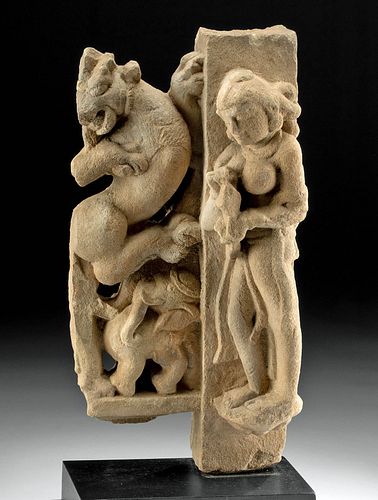10th C. Indian Rajasthan Relief Lion, Elephant, Consort
About Seller
686 S Taylor Ave, Ste 106
Louisville, CO 80027
United States
Selling antiquities, ancient and ethnographic art online since 1993, Artemis Gallery specializes in Classical Antiquities (Egyptian, Greek, Roman, Near Eastern), Asian, Pre-Columbian, African / Tribal / Oceanographic art. Our extensive inventory includes pottery, stone, metal, wood, glass and textil...Read more
Two ways to bid:
- Leave a max absentee bid and the platform will bid on your behalf up to your maximum bid during the live auction.
- Bid live during the auction and your bids will be submitted real-time to the auctioneer.
Bid Increments
| Price | Bid Increment |
|---|---|
| $0 | $25 |
| $300 | $50 |
| $1,000 | $100 |
| $2,000 | $250 |
| $5,000 | $500 |
| $10,000 | $1,000 |
| $20,000 | $2,500 |
| $50,000 | $5,000 |
| $100,000 | $10,000 |
| $200,000 | $20,000 |
About Auction
Nov 10, 2022
Museum-worthy examples of classical antiquities (Egyptian, Greek, Roman, Near Eastern), Viking, Far East / Asian, Pre-Columbian, African / Tribal, Oceanic, Native American, Spanish Colonial, Nautical, Fossils, Ancient Jewelry, Fine / Visual Arts, so much more! Artemis Fine Arts info@artemisfinearts.com
- Lot Description
South Asia, India, Rajasthan, ca. 10th to 13th century CE. A remarkable figural relief sculpture, meticulously carved from sandstone to depict a lion, an elephant, and a female consort. Posed as if climbing up the wall, the ferocious feline looks back over its shoulder to face left as the comparably petite elephant stands below it, wearing a slender headband and also gazing left. The sensual consort or apsara stands to the right, displaying a slender, scantily clad body with voluptuous breasts. She holds an object in both hands and gazes downward, her heavenly visage framed by elongated ears, bulbous earrings, and an elaborate coiffure, as collar necklaces adorn her chest. A special example from Rajasthan, in northeastern India, which has a unique artistic tradition that is rarely seen in Western collections. Size: 8.6" W x 17.4" H (21.8 cm x 44.2 cm); 20.2" H (51.3 cm) on included custom stand.
Surviving ancient reliefs and carvings from monuments, religious sites, tombs, and palaces - being some of the most durable forms of art - inform us about the beliefs of ancient peoples throughout the world and human history. How remarkable that virtually all cultures have felt the need to express their creative sides in this vein.
According to Pushkar Sohoni in "Old fights, new meanings: Lions and elephants in combat" (Res: Anthropology and aesthetics 2016/2017, vol. 67-68: 225-234 pp.), "For over a millennium in South Asia, the visual trope of a triumphant lion vanquishing one or several elephants has been common in architectural sculpture, both in the round and in relief... In the rather limited scholarship on this motif, diverse interpretations have been offered. Although its presence has remained fairly stable through time, there exist many minor variations on this motif, including the use of leonine creatures variously described as vyalas or yalis, and the incorporation of other fantastic creatures known popularly as makaras in such combats. In South India, the myth of the fantastic composite animal called the Sarabha takes this imagery yet further. Yet, the simple image of a lion victorious over one or more elephants was situated very strategically within certain architectural programs for given periods and places."
Cf. Figures 1, 4, and 6 in Sohoni, Pushkar, "Old fights, new meanings: Lions and elephants in combat" (Res: Anthropology and aesthetics 2016/2017, vol. 67-68: 225-234 pp.).
Provenance: private Hawaii, USA collection; ex-Earl Stendahl collection; ex-Alfred Stendahl collection, acquired from 1950s to 1960s; ex-London, United Kingdom collection
All items legal to buy/sell under U.S. Statute covering cultural patrimony Code 2600, CHAPTER 14, and are guaranteed to be as described or your money back.
A Certificate of Authenticity will accompany all winning bids.
We ship worldwide and handle all shipping in-house for your convenience.
#108990Fragment of a larger piece. Weather worn with a few old losses to peripheries commensurate with age. Some expected nicks, chips, abrasions, and softening of detail, as shown. Otherwise, excellent with light earthen deposits throughout. Old collection number inscribed on verso.Condition
- Shipping Info
-
Artemis Gallery will no longer be able to offer in-house shipping for most international orders, as well as all oversized orders, including most paintings. These items are clearly marked in the listing as “3rd Party Shipping Required” in the listing. We have a list of recommended third party shippers to assist you in shipping to and from, and would be happy to assist you in working with them. We require a written authorization from the client to release property to any third party. You may fax a Shipping Release Form to 303-828-3235 or email your authorization to kristen@artemisgallery.com. Please note the all property must be removed from our premises within seven (7) business days following the last day of the auction.
-
- Buyer's Premium



 EUR
EUR CAD
CAD AUD
AUD GBP
GBP MXN
MXN HKD
HKD CNY
CNY MYR
MYR SEK
SEK SGD
SGD CHF
CHF THB
THB














